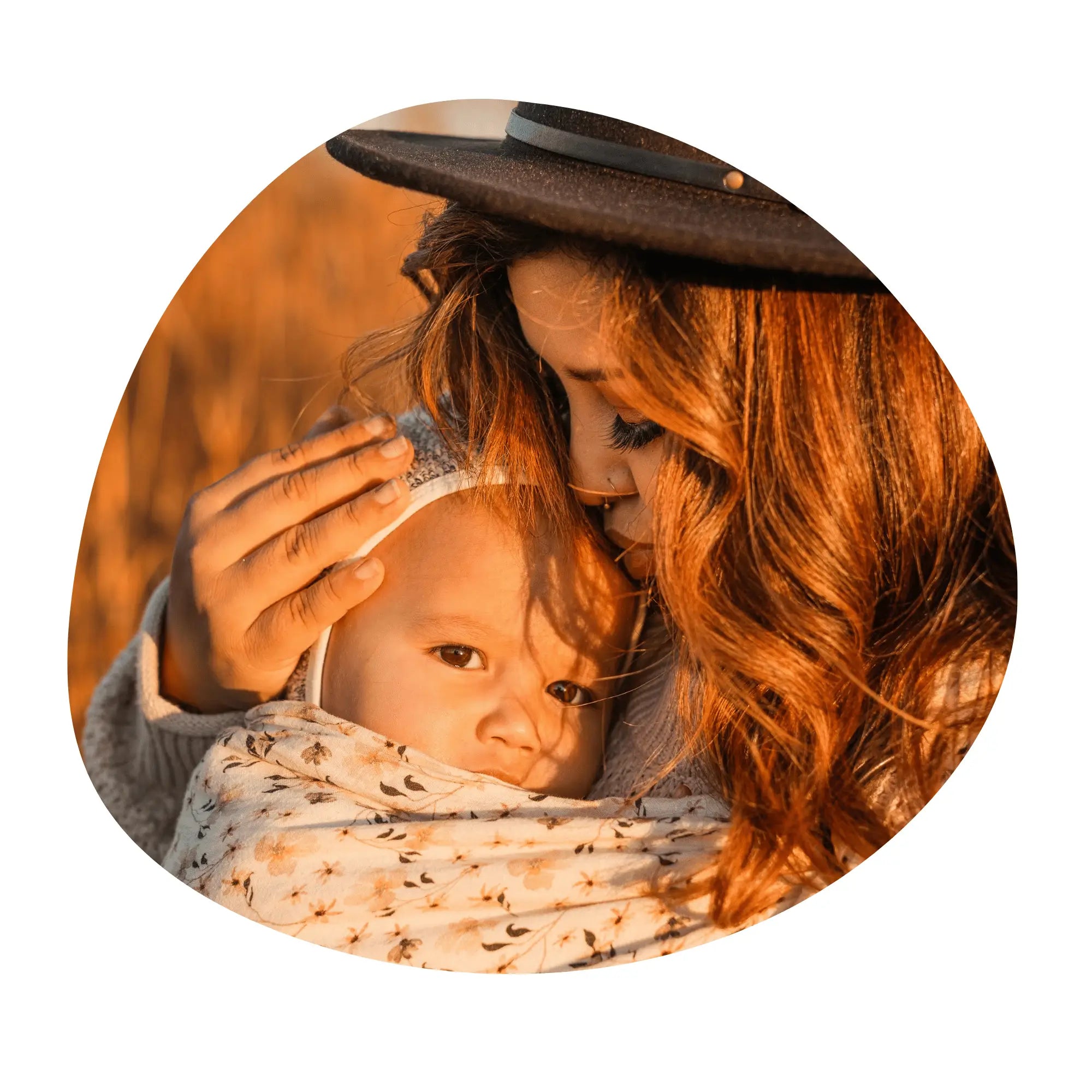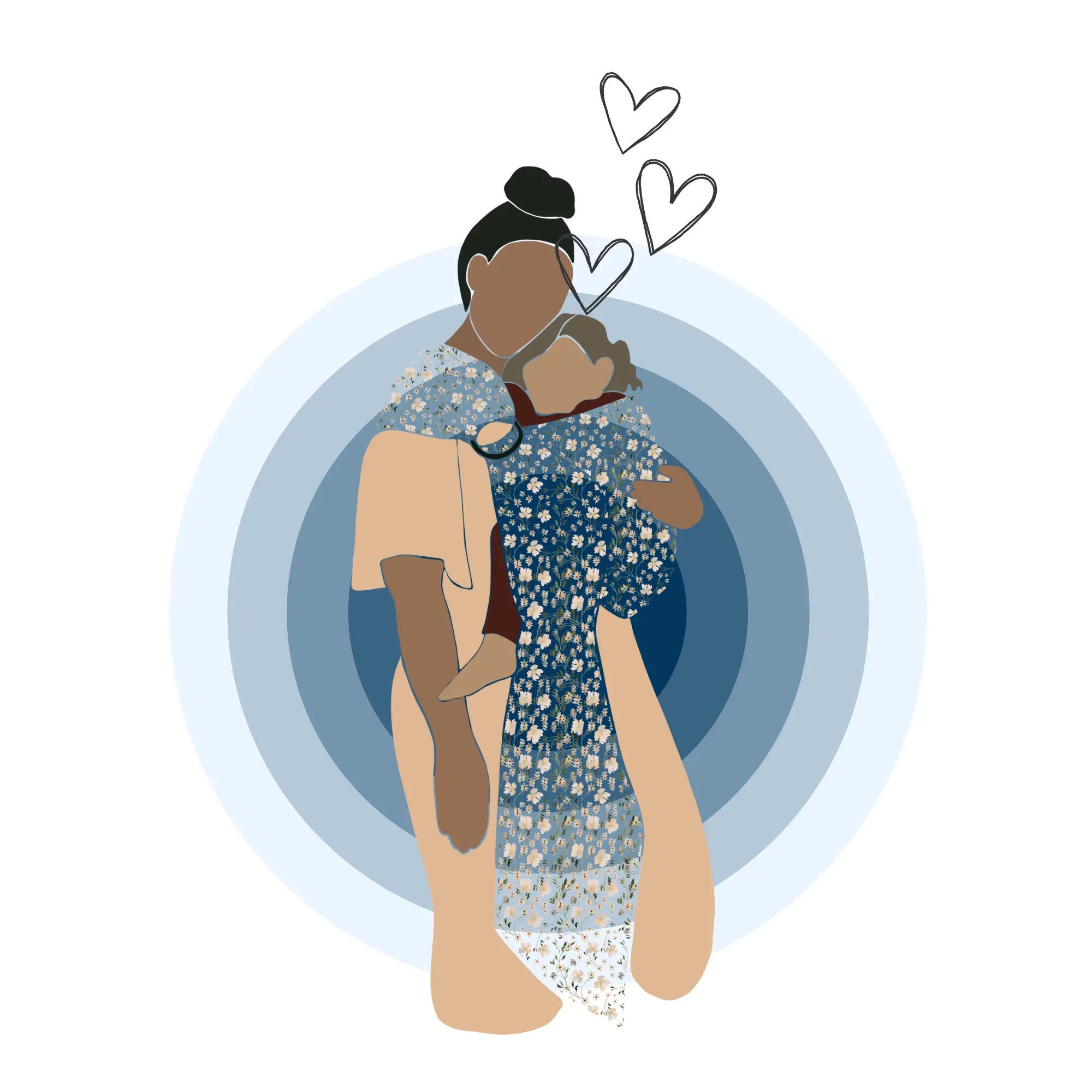Safe and Snuggly Babywearing: hope&plum's Newborn Carrier Tips
Babywearing is an incredible parenting tool that allows caregivers to hold their babies close while being hands-free. If you can, babywearing from the very beginning of your child’s life sets everyone up for success! Newborns experiencing the loud, bright, cold world for the first time just want to be held. And sleep-deprived caregivers are trying to fold their new little bundle of joy into their lives. Enter babywearing! But how can you do it safely with that tiny, precious squish? hope&plum is here to guide you through babywearing in the newborn stage!
Newborn Need to Knows
Safety is #1 for newborns. It’s really #1 for all babywearing, but wearers have to be extra vigilant when wearing fresh babies since newborns lack the head, neck, and trunk control to keep themselves safe. A good acronym to keep in mind is T.I.C.K.S.
These safety guidelines apply to all children but are especially important for newborns. 👇
T - Tight - Your carrier should be snug to you and your newborn. You and your baby should be comfortable, but there should be no loose or bunched fabric. Baby should be snug to your body with little to no space between you, especially when the baby is resting.
I - In View - You should be able to see your baby at all times. This is integral for newborn wearing since you want to visually monitor their positioning and airway. You can also monitor your baby’s legs and feet for signs of decreased circulation. The Baby’s head and face should always be visible above the fabric.
C - Close Enough to Kiss - Your newborn's head should be high enough on your chest so that you can easily bend your neck and kiss the top of their head. You shouldn’t have to extend or strain your neck. You should be able to kiss the baby’s head with a simple downward nod.
K - Keep Chin Off Chest - You should always be able to fit at least two fingers between your newborn’s chin and chest. Newborns' airways are like bendy straws. You never want the straw to close up by folding too dramatically. And newborns lack the neck strength to straighten themselves out. This is where having a baby “In View” will also help. A “Tight” carry where the baby is “Close Enough to Kiss” will also help protect their fragile airway.
S - Supported Back - Your carrier should be tight enough to support your baby’s back/spine/trunk, especially since newborns lack the strength to support themselves. If your carrier is “tight” enough and tightened properly, the baby will be upright with their head leaning on your chest and their back supported appropriately.
You should check for each individually, but, as demonstrated, they work together to ensure a safe fit for your newborn!
Baby Wraps
hope&plum baby wraps are stretchy wraps. They are a lightweight tencel/organic cotton blend with two-way stretch that comes in a variety of solid colors and patterns. Our baby wraps are super snuggly and perfect for newborns. One great newborn feature is that their two-way stretch makes them poppable carriers. This means you can tie a baby wrap on once and, as long as you get it nice and tight to start off, you can leave it on all day, popping baby in and out as needed!
Need to feed your newborn every two hours? Pop baby out! Need to change that diaper immediately after another change? Pop baby out! Need to get your newborn from your house to your car, their care provider, and the scale to the exam room? Pop baby out, pop baby in, repeat as needed! Always ensure that your fit meets the T.I.C.K.S. guidelines as you use it throughout the day.
The weight limit on our baby wraps is 35 lbs, but unless you get a perfectly tight fit, many people feel like they are not as comfortable or supportive after a baby reaches about 20 lbs. This makes them an ideal newborn carrier!
Ring Slings
Our ring slings provide next level squishy snuggles for your newborn. Honestly, what is sweeter than a tiny newborn face sleeping soundly in a ring sling? hope&plum ring slings are either made from a hemp/organic cotton or linen/cotton blend, both supportive and comfortable. Most babies can fit from birth in a high and tight front carry. Wearing your newborn with their legs out is safe from birth. If your baby loves that newborn scrunch position and simply won’t tolerate having their legs out, the legs in position is also safe, but you should stop this position once your baby is pushing up on the fabric to stand.
Like baby wraps, ring slings are also poppable, but with a few more adjustments each time you take baby in our out. Ring slings are a great option for feeding your newborn, although feeding in the carrier may not be handsfree until your baby has a bit more head, neck, and trunk control. One of the best things about a ring sling is that it will grow with your baby throughout toddlerhood and beyond!
Meh Dais
Meh dais are like the best of both worlds. They provide the same two-shoulder support of a baby wrap, but will grow with your child beyond infancy. hope&plum meh dais are made of hemp/organic cotton blend with an adjustable ring waist and luxuriously wide wrap straps to offer the utmost support!
The meh dai panels are rollable and cinchable to accommodate most newborns from birth. They are a bit easier to learn than the baby wrap or ring sling, so getting that high, tight carry with proper back support and alignment is easier.
Like ring slings, they are an excellent option for feeding a newborn, keeping in mind that it may not be a hands-free activity for a few months. Also, like the ring sling, the meh dai will grow with your infant through toddlerhood and beyond. Older babies and toddlers can easily be worn in a back carry, with many fancy and supportive finish options.
Wait a Second… What about the Lark?!
It’s true – while the Lark is hope&plum’s best-selling carrier, it isn’t for newborns! The weight minimum on the Lark is 10 pounds, but achieving an optimal and safe fit is much more than a weight guideline. We tend to find babies fit well in the Lark when they fit in 3-6 month clothes across brands for both torso height and leg length. And then we always have to go back to T.I.C.K.S. to make sure the baby is high, tight, and properly supported in the carrier.
Here are some additional safety checks you can do with your smaller babies in a Lark:
Top of the Panel - You want to make sure the baby is safely clearing the top of the panel. This means the top of the panel should come no higher than the baby’s earlobes. If the panel comes higher than that, you won’t be able to see the baby as clearly as needed to check on positioning and airway.
Bottom of Panel - You want to ensure the baby safely clears the bottom of the panel. This means the bottom of the panel should support the baby from one knee to the other without going past their knees. Their knees should always be able to bend freely. If not, you could be over-extending your baby’s legs.
Side Gaps - You want to ensure you’re closing off the side gaps so that the baby won’t fall out of the carrier. Some babies may be too small to get the carrier properly tightened to close off any significant gaps between the sides of the panel and the wearer’s body. This puts the baby at a fall risk.
Kissable - As always, you want to make sure the baby’s head is close enough to kiss without straining your neck.
If you can’t check off those four safety guidelines, your baby is still too small for the Lark. You can always schedule a fit check if you’re unsure or want some small baby tips. And you can use your baby wrap, ring sling, or meh dai until the baby can safely fit in the Lark.
Summary
Babywearing keeps newborns close while allowing caregivers to be hands-free.
Follow T.I.C.K.S. for safe and proper newborn positioning.
Our baby wraps are stretchy and lightweight. They're perfect for newborns with easy in-and-out use.
Our ring slings are adjustable and snuggly. They're great for newborns and grow with them.
Our meh dais offer two-shoulder support, are easy to use, and adapt as baby grows.
The Lark is best for older babies who are over 10 lbs and fitting 3-6 month clothing.












